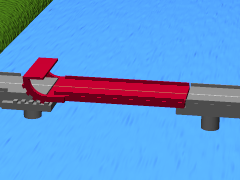 The Wells Street Bridge (Chicago), a double-leaf fixed-trunnion bascule bridge | |
| Ancestor | Drawbridge, Plate girder bridge, cantilever bridge |
|---|---|
| Related | Lift bridge, swing bridge |
| Descendant | None |
| Carries | Pedestrian, bicycle, automobile, truck, light rail, heavy rail |
| Span range | Short |
| Material | Steel |
| Movable | Yes |
| Design effort | Medium |
| Falsework required | Site and prefabrication specific |
A bascule bridge (also referred to as a drawbridge or a lifting bridge) is a moveable bridge with a counterweight that continuously balances a span, or leaf, throughout its upward swing to provide clearance for boat traffic. It may be single- or double-leafed.
Contents
The name comes from the French term for balance scale, which employs the same principle. Bascule bridges are the most common type of movable span because they open quickly and require relatively little energy to operate, while providing the possibility for unlimited vertical clearance for marine traffic.





